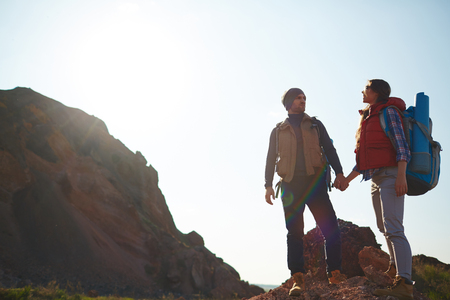1. Introduction to U.S. Hiking and Conservation Organizations
Hiking is a beloved outdoor activity across the United States, bringing together people who enjoy exploring nature, staying active, and appreciating America’s beautiful landscapes. At the heart of this community are numerous hiking organizations and conservation groups that play key roles in supporting both recreational opportunities and the protection of natural spaces.
Major Hiking Associations in the U.S.
The U.S. has several influential hiking associations, each with its own mission and history. These organizations not only maintain trails but also promote safety, education, and stewardship among hikers.
| Organization | Founded | Main Mission | Key Activities |
|---|---|---|---|
| Appalachian Trail Conservancy (ATC) | 1925 | Preserve and manage the Appalachian Trail | Trail maintenance, volunteer coordination, education |
| American Hiking Society (AHS) | 1976 | Promote and protect foot trails and their surrounding natural areas | Advocacy, National Trails Day®, trail grants |
| Pacific Crest Trail Association (PCTA) | 1977 | Protect, preserve, and promote the Pacific Crest Trail corridor | Trail work, land stewardship, community outreach |
| The Mountaineers | 1906 | Enrich lives through outdoor education and conservation | Courses, events, advocacy for public lands |
Key Conservation Groups in the U.S.
Conservation groups focus on protecting ecosystems, wildlife habitats, and public lands for future generations. Many of these groups partner with hiking organizations to ensure both access to trails and long-term environmental health.
| Group Name | Founded | Main Mission | Main Focus Areas |
|---|---|---|---|
| The Nature Conservancy (TNC) | 1951 | Conserve lands and waters on which all life depends | Land acquisition, habitat restoration, policy advocacy |
| Sierra Club | 1892 | Explore, enjoy, and protect the planet | Grassroots activism, outings, lobbying for conservation laws |
| The Wilderness Society (TWS) | 1935 | Protect wilderness and inspire Americans to care for wild places | Public lands protection, research, community engagement |
| The Trust for Public Land (TPL) | 1972 | Create parks and protect land for people to ensure healthy communities for generations to come | Parks creation, urban green spaces, land conservation projects |
Their Roles in the Outdoor Community
Together, these hiking associations and conservation groups form a strong network that supports outdoor recreation while safeguarding natural resources. They provide opportunities for volunteers to get involved with trail building or habitat restoration projects. They also advocate for policies that protect public lands so everyone can continue enjoying America’s great outdoors.
2. Shared Goals and Common Ground
When hiking organizations and conservation groups work together in the U.S., they often find that their core interests overlap in meaningful ways. These partnerships are rooted in a shared commitment to protect natural spaces for both present and future generations. Below, we highlight some of the most important mutual goals that bring these groups together.
Protecting Public Lands
Both hiking organizations and conservation groups understand the importance of keeping public lands open, accessible, and healthy. By joining forces, they advocate for policies that safeguard national parks, forests, and other public areas from threats such as development or resource extraction. Their combined voices carry more weight when speaking up for the protection of these treasured landscapes.
Preserving Wildlife Habitats
Another major area of common ground is the preservation of habitats for wildlife. Hiking trails often pass through sensitive ecosystems, so both groups strive to minimize human impact on plants and animals. This collaboration helps ensure that diverse species can thrive while people enjoy the outdoors responsibly.
Promoting Sustainable Trail Use
Sustainable use of trails is vital to maintaining access for everyone without damaging natural resources. Partnerships between hiking clubs and conservation organizations help educate hikers about responsible behaviors, like staying on marked paths or packing out trash. They also work together on trail maintenance projects that reduce erosion and keep trails safe for all users.
Key Areas of Collaboration
| Shared Interest | How They Collaborate |
|---|---|
| Public Land Protection | Joint advocacy campaigns and educational events |
| Wildlife Habitat Preservation | Trail planning to avoid sensitive zones; habitat restoration projects |
| Sustainable Trail Use | Volunteer-led trail maintenance; Leave No Trace workshops |
The Foundation for Strong Partnerships
This shared mission forms the backbone of successful partnerships across the U.S. By working together, hiking organizations and conservation groups amplify their efforts to protect nature, making sure our favorite outdoor places remain beautiful and accessible for years to come.
![]()
3. Successful Partnership Models
Examining Notable Collaborations
Partnerships between hiking organizations and conservation groups in the U.S. have led to some inspiring success stories. These partnerships combine resources, expertise, and passion for the outdoors, resulting in stronger protection for trails and natural areas. Let’s take a closer look at a few standout models.
Key Examples of Effective Partnerships
| Organizations Involved | Main Focus | Notable Outcomes |
|---|---|---|
| Appalachian Trail Conservancy & National Park Service | Stewardship of the Appalachian Trail (AT) | Co-managed 2,190-mile trail; volunteer programs; habitat restoration |
| Pacific Crest Trail Association & U.S. Forest Service | Trail maintenance and preservation of the Pacific Crest Trail (PCT) | Volunteer-led trail work; education initiatives; land protection efforts |
| Minnesota Rovers Outdoors Club & Minnesota Land Trust | Community conservation and outdoor recreation access | Organized stewardship events; local land protection projects |
| Sierra Club & Leave No Trace Center for Outdoor Ethics | Promoting sustainable hiking practices nationwide | Workshops on responsible recreation; public awareness campaigns |
Joint Stewardship Programs and Community Initiatives
Many partnerships go beyond maintaining trails—they also focus on education and community engagement. For example, joint stewardship programs often bring together volunteers from both hiking clubs and environmental organizations to conduct cleanups, invasive species removal, and trail building days. Community initiatives like “Adopt-a-Trail” encourage local hikers to take ownership of trail segments, fostering pride and long-term care.
Why These Models Work Well
- Shared Goals: Both groups want to protect nature and keep trails open for everyone.
- Diverse Skills: Conservationists bring scientific know-how, while hiking groups offer strong volunteer networks.
- Broader Reach: Working together helps spread the word about conservation to more people.
- Sustainable Funding: Partnerships can unlock grants or donations that neither group could get alone.
This collaborative approach not only keeps America’s most beloved trails safe and beautiful but also builds a stronger outdoor community across the country.
4. Challenges in Collaboration
Understanding the Roadblocks
Working together isn’t always easy, even for groups with similar goals. Hiking organizations and conservation groups across the U.S. face some common challenges when they try to collaborate. These include funding issues, different organizational priorities, and public policy obstacles.
Common Collaboration Challenges
| Challenge | Description | Example |
|---|---|---|
| Funding Constraints | Limited budgets can make it tough to launch joint projects or maintain trails and conservation programs. | A hiking club and a land trust both want to restore a trail but can’t agree on who pays for materials or labor. |
| Differing Priorities | Each group may focus on different goals—some prioritize recreation access, others focus on protecting habitats. | A hiking organization wants more trail access, while the conservation group wants restricted use to protect wildlife. |
| Public Policy Hurdles | Laws and regulations at local, state, or federal levels can slow down projects or make collaboration complicated. | Permitting delays from federal agencies can halt trail improvements supported by both groups. |
How Organizations Overcome These Challenges
Despite these roadblocks, many partnerships find creative ways to work together effectively. Here are some strategies that have helped:
- Shared Funding Initiatives: Some organizations pool resources or seek joint grants to fund projects that benefit both hikers and conservation efforts.
- Open Communication: Regular meetings and honest discussions help groups understand each other’s priorities and find common ground.
- Advocacy and Policy Engagement: Partnering on advocacy campaigns helps change policies or secure permits needed for shared projects.
- Pilot Programs: Starting with small, low-risk projects allows groups to build trust before tackling larger initiatives together.
- Mediation and Third-Party Facilitation: Sometimes, bringing in an impartial facilitator can help resolve conflicts over land use or resource allocation.
Real-World Example: Trail Restoration Partnerships
The Pacific Crest Trail Association often partners with The Nature Conservancy and state agencies. They overcome funding gaps by applying for government grants together and host joint volunteer days so both missions are served—keeping the trail open for hikers while preserving sensitive ecosystems nearby.
5. The Future of Outdoor Alliances
Emerging Trends in Collaboration
Across the United States, hiking organizations and conservation groups are teaming up in exciting new ways. Traditional trail maintenance is just the beginning—now, these partnerships often include educational programs, youth outreach, and community science projects. With more people enjoying the outdoors than ever before, collaboration is key to balancing recreation with environmental stewardship.
Innovative Citizen Science Projects
One of the biggest trends is the rise of citizen science, where hikers and outdoor enthusiasts collect valuable data while on the trail. These projects help track wildlife, monitor plant health, or report trail conditions. Thanks to easy-to-use apps and online tools, anyone can contribute meaningful information that supports conservation goals.
| Project Name | Main Focus | How Hikers Get Involved |
|---|---|---|
| iNaturalist | Biodiversity Tracking | Upload photos of plants and animals for identification |
| Trailhead Condition Reports | Trail Maintenance | Submit updates on trail erosion or obstacles via mobile app |
| Audubon Christmas Bird Count | Bird Population Monitoring | Participate in annual bird counting events on trails |
The Role of Technology in Partnerships
Technology is making it easier for hiking organizations and conservation groups to connect with each other—and with the public. Social media campaigns spread awareness about stewardship, while GPS mapping tools help volunteers efficiently manage trails. Digital newsletters keep communities informed about events and advocacy efforts. Many groups also use virtual meetings to train volunteers or coordinate large-scale conservation projects across state lines.
Examples of Technology Shaping Outdoor Partnerships:
- Mobile Apps: Guide hikers to Leave No Trace practices or allow instant reporting of issues.
- Drones: Help survey remote areas for invasive species or habitat restoration needs.
- Online Fundraising: Crowdfunding platforms make it simple to support trail building or habitat protection campaigns.
The Power of Advocacy Campaigns
Advocacy is a growing part of outdoor alliances. Hiking and conservation groups join forces to support legislation that protects public lands, secures funding for parks, and ensures sustainable access for everyone. Through letter-writing drives, social media challenges, and local government outreach, these alliances are amplifying their voices like never before.


